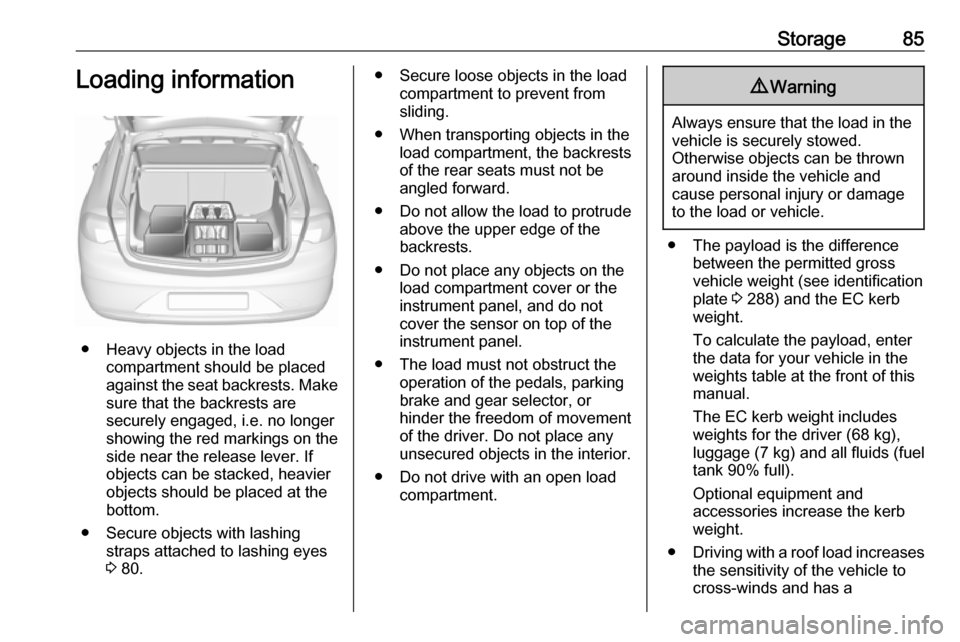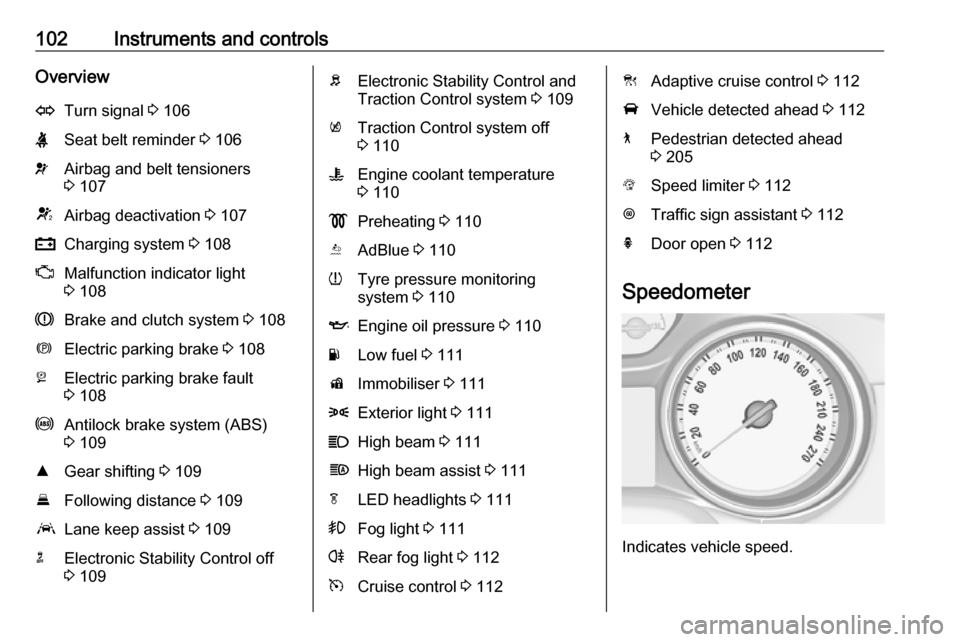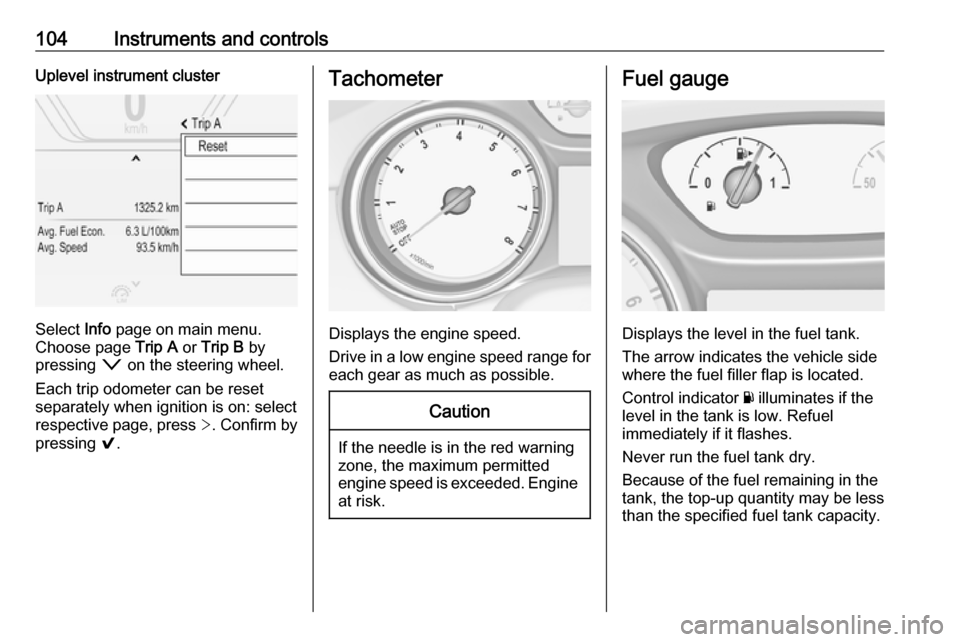fuel OPEL INSIGNIA BREAK 2017.75 Manual user
[x] Cancel search | Manufacturer: OPEL, Model Year: 2017.75, Model line: INSIGNIA BREAK, Model: OPEL INSIGNIA BREAK 2017.75Pages: 323, PDF Size: 9.18 MB
Page 24 of 323

22Keys, doors and windows2. Insert the key blade again forapprox. 6 mm and turn the key to
open the housing. Further
insertion of the key blade can
damage the housing.
3. Remove and replace battery. Use
CR 2032 or equivalent battery.
Pay attention to the installation
position.
4. Close the housing and insert key blade.
Batteries do not belong in household
waste. They must be disposed of at
an appropriate recycling collection
point.
Fault
If the central locking cannot be
operated or the engine cannot be
started, the cause may be one of the
following:
● Fault in electronic key.
● Electronic key is out of reception range.
● The battery voltage is too low.● Overload of the central locking system by operating at frequent
intervals, the power supply is
interrupted for a short time.
● Interference from higher-power radio waves from other sources.
To rectify the cause of the fault,
change the position of the electronic
key.
Manual unlocking 3 22.
Memorised settings
Whenever the ignition is switched off, the following settings are
automatically memorised by the
electronic key:
● automatic climate control
● lighting
● Infotainment system
● central locking system
● Sport mode settings
● comfort settings
The saved settings are automatically
used the next time the ignition is
switched on with the memorised
electronic key 3 20.A precondition is that Personalisation
by Driver is activated in the personal
settings of the Info-Display. This must
be set for each electronic key which is used. The status change is available
only after locking and unlocking the
vehicle.
The assigned memory position of the
power seat is automatically recalled
when switching on ignition and Auto
Memory Recall is activated in the
Info-Display for the memorised electronic key.
Power seat 3 49.
Vehicle personalisation 3 126.
Central locking system
Unlocks and locks doors, load
compartment and fuel filler flap.
A pull on an interior door handle
unlocks the respective door. Pulling
the handle once more opens the door.
Note
In the event of an accident in which
airbags or belt pretensioners are
deployed, the vehicle is
automatically unlocked.
Page 25 of 323

Keys, doors and windows23Note
A short time after unlocking with the
electronic key, the doors are being
locked automatically if no door has
been opened. A precondition is that
the setting is activated in the vehicle
personalisation 3 126.
Electronic key system operation
The electronic key must be outside
the vehicle, within a range of approx. one metre of the relevant door side.
Unlocking
Press the button on the respective
exterior door handle and pull the
handle.
Unlocking mode can be set in the
vehicle personalisation menu in the
Info-Display. Two settings are
selectable:
● All doors, load compartment and fuel filler flap will be unlocked by
pressing the button on any
exterior handle once.
● Only the driver's door, load compartment and fuel filler flap
will be unlocked by pressing the
button on the driver's door
exterior handle once. To unlock
all doors, press button twice.
The setting can be changed in the
menu Settings in the Info-Display.
Vehicle personalisation 3 126.
Locking
Press the button on any exterior door
handle.
All doors, load compartment and fuel
filler flap will be locked.
Page 26 of 323

24Keys, doors and windowsThe system locks if any of the
following occurs:
● It has been more than five seconds since unlocking.
● The button on an exterior handle has been pressed twice within
five seconds to unlock the
vehicle.
● Any door has been opened and all doors are now closed.
If the driver's door is not closed
properly, the electronic key remains in the vehicle or the ignition is not off,
locking will not be permitted.
If there have been two or more
electronic keys in the vehicle and the
ignition was on once, the doors will be locked even if just one electronic key
is taken out of the vehicle.
Unlocking and opening the tailgate
The tailgate can be unlocked and
opened handsfree via moving the foot below the rear bumper or by pushing
the touchpad switch under the brand
emblem when the electronic key is in
range. The doors remain locked.
Load compartment 3 27.Operation with buttons on the
electronic key
The central locking system can also
be operated with the buttons on the
electronic key.
Press c to unlock.
Press e to lock.
Electronic key system 3 20.
Passive locking
Automatic locking 3 26.
Confirmation
Operation of central locking system is
confirmed by the hazard warning
flashers. A precondition is that the
setting is activated in the vehicle
personalisation 3 126.
Central locking buttons Locks or unlocks all doors, the load
compartment and fuel filler flap from
the passenger compartment via a
switch in the driver's door panel.
Press e to lock. LED in button
illuminates.
Press c to unlock.
Page 27 of 323

Keys, doors and windows25Operation with the key in case of
a central locking system fault
In case of a fault, e.g. vehicle battery
or electronic key battery is
discharged, the driver's door can be
locked or unlocked with the key blade.
Push the button on the electronic key
and pull out the key blade.
The lock cylinder in the driver's door is covered by a cap.
Insert the key blade into the recess at the bottom of the cap and swivel the
key upward.
Manual unlocking
Manually unlock the driver's door by
inserting and turning the key blade in
the lock cylinder.
The other doors can be opened by
pulling the interior handle twice or by
pressing c in the driver's door panel.
The load compartment and fuel filler
flap will possibly not be unlocked.
By switching on the ignition, the anti-
theft locking system is deactivated.
Manual locking
Push inside locking knob of all doors
except driver's door or press e in the
driver's door panel. Then close the driver's door and lock it from the
Page 28 of 323

26Keys, doors and windowsoutside by turning the key in the lock
cylinder. The fuel filler flap and
tailgate are possibly not locked.
After locking, cover the lock cylinder
with the cap: insert the cap with the
lower side in the recesses, swivel and
push the cap until it engages at the
upper side.
Automatic locking
Automatic locking after driving off
This security feature can be
configured to automatically lock all
doors, load compartment and fuel
filler flap after driving off and
exceeding a certain speed.
When at a standstill after driving, the
vehicle will be unlocked automatically
as soon as the key is removed from
the ignition switch, or with electronic
key system when the ignition is
switched off.
Activation or deactivation of
automatic locking can be set in the
menu Settings , I Vehicle in the Info-
Display.
Info-Display 3 120.
Vehicle personalisation 3 126.
The setting can be saved for each
electronic key being used 3 22.
Automatic relock after unlocking
This feature can be configured to
automatically lock all doors, load
compartment and fuel filler flap ashort time after unlocking with the
remote control or electronic key,
provided no door has been opened.
Activation or deactivation of
automatic relock can be set in the
menu Settings , I Vehicle in the Info-
Display.
Info-Display 3 120.
Vehicle personalisation 3 126.
The setting can be saved for each
electronic key being used 3 22.
Passive locking This feature locks the vehicle
automatically after several seconds if
an electronic key has been
recognised previously inside the
vehicle, all doors have then been
closed and the electronic key does
not remain within the vehicle.
If the electronic key remains in the
vehicle or the ignition is not off,
passive locking will not be permitted.
If there have been two or more
electronic keys in the vehicle and the
ignition was on once, the feature
locks the vehicle if just one electronic key is taken out of the vehicle.
Page 29 of 323

Keys, doors and windows27To prevent passive locking of the
vehicle e.g. when refuelling or if
passengers remain in the vehicle, the
system must be disabled.
To disable the system, press the
central locking button c for a few
seconds while one door is open. An
acoustic signal sounds three times to
confirm deactivation. The function
remains disabled until the central
locking button e is pressed or the
ignition is switched on.
Activation or deactivation of passive
locking can be set in the menu
Settings , I Vehicle in the Info-Display.
Info-Display 3 120.
Vehicle personalisation 3 126.
The setting can be saved for each electronic key being used 3 22.Child locks9 Warning
Use the child locks whenever
children are occupying the rear
seats.
Move the pin in the rear door to the front position. The door cannot be
opened from the inside.
To deactivate, move the pin to the
rear position.
Doors
Load compartment
Tailgate Opening5-door Hatchback
After unlocking, push the brand
emblem and open the tailgate.
Page 87 of 323

Storage85Loading information
● Heavy objects in the loadcompartment should be placed
against the seat backrests. Make
sure that the backrests are
securely engaged, i.e. no longer
showing the red markings on the side near the release lever. If
objects can be stacked, heavier
objects should be placed at the
bottom.
● Secure objects with lashing straps attached to lashing eyes
3 80.
● Secure loose objects in the load
compartment to prevent from
sliding.
● When transporting objects in the load compartment, the backrestsof the rear seats must not be
angled forward.
● Do not allow the load to protrude above the upper edge of the
backrests.
● Do not place any objects on the load compartment cover or theinstrument panel, and do not
cover the sensor on top of the instrument panel.
● The load must not obstruct the operation of the pedals, parking
brake and gear selector, or
hinder the freedom of movement of the driver. Do not place any
unsecured objects in the interior.
● Do not drive with an open load compartment.9Warning
Always ensure that the load in the
vehicle is securely stowed.
Otherwise objects can be thrown
around inside the vehicle and
cause personal injury or damage
to the load or vehicle.
● The payload is the difference between the permitted grossvehicle weight (see identification
plate 3 288) and the EC kerb
weight.
To calculate the payload, enter the data for your vehicle in the
weights table at the front of this
manual.
The EC kerb weight includes
weights for the driver (68 kg),
luggage (7 kg) and all fluids (fuel
tank 90% full).
Optional equipment and
accessories increase the kerb
weight.
● Driving with a roof load increases
the sensitivity of the vehicle to
cross-winds and has a
Page 89 of 323

Instruments and controls87Instruments and
controlsControls ....................................... 88
Steering wheel adjustment ........88
Steering wheel controls .............88
Heated steering wheel ...............89
Horn ........................................... 89
Windscreen wiper/washer .........89
Rear window wiper/washer .......91
Outside temperature ..................92
Clock ......................................... 92
Power outlets ............................. 94
Inductive charging .....................95
Ashtrays .................................... 96
Warning lights, gauges and indi‐ cators ........................................... 97
Instrument cluster ......................97
Speedometer ........................... 102
Odometer ................................ 103
Trip odometer .......................... 103
Tachometer ............................. 104
Fuel gauge .............................. 104
Engine coolant temperature gauge ..................................... 105
Service display ........................ 105
Control indicators ....................106Turn signal............................... 106
Seat belt reminder ...................106
Airbag and belt tensioners .......107
Airbag deactivation ..................107
Charging system .....................108
Malfunction indicator light ........108
Brake and clutch system .........108
Electric parking brake ..............108
Electric parking brake fault ......108
Antilock brake system (ABS) ...109
Gear shifting ............................ 109
Following distance ...................109
Lane keep assist .....................109
Electronic Stability Control off . 109
Electronic Stability Control and Traction Control system .........109
Traction Control system off .....110
Engine coolant temperature ....110
Preheating ............................... 110
AdBlue ..................................... 110
Tyre pressure monitoring system .................................... 110
Engine oil pressure ..................110
Low fuel ................................... 111
Immobiliser .............................. 111
Exterior light ............................ 111
High beam ............................... 111
High beam assist .....................111
LED headlights ........................ 111
Fog light ................................... 111Rear fog light........................... 112
Cruise control .......................... 112
Adaptive cruise control ............112
Vehicle detected ahead ...........112
Pedestrian detection ................112
Speed limiter ........................... 112
Traffic sign assistant ................112
Door open ................................ 112
Information displays ...................113
Driver Information Centre ........113
Info display .............................. 120
Head-up display ......................122
Vehicle messages ......................124
Warning chimes .......................125
Battery voltage ........................ 125
Vehicle personalisation ..............126
Telematics service .....................130
OnStar ..................................... 130
Page 104 of 323

102Instruments and controlsOverviewOTurn signal 3 106XSeat belt reminder 3 106vAirbag and belt tensioners
3 107VAirbag deactivation 3 107pCharging system 3 108ZMalfunction indicator light
3 108RBrake and clutch system 3 108mElectric parking brake 3 108jElectric parking brake fault
3 108uAntilock brake system (ABS)
3 109RGear shifting 3 109EFollowing distance 3 109aLane keep assist 3 109nElectronic Stability Control off
3 109bElectronic Stability Control and
Traction Control system 3 109kTraction Control system off
3 110WEngine coolant temperature
3 110!Preheating 3 110YAdBlue 3 110wTyre pressure monitoring
system 3 110IEngine oil pressure 3 110YLow fuel 3 111dImmobiliser 3 1118Exterior light 3 111CHigh beam 3 111fHigh beam assist 3 111fLED headlights 3 111>Fog light 3 111rRear fog light 3 112mCruise control 3 112CAdaptive cruise control 3 112AVehicle detected ahead 3 1127Pedestrian detected ahead
3 205LSpeed limiter 3 112LTraffic sign assistant 3 112hDoor open 3 112
Speedometer
Indicates vehicle speed.
Page 106 of 323

104Instruments and controlsUplevel instrument cluster
Select Info page on main menu.
Choose page Trip A or Trip B by
pressing o on the steering wheel.
Each trip odometer can be reset separately when ignition is on: select
respective page, press >. Confirm by
pressing 9.
Tachometer
Displays the engine speed.
Drive in a low engine speed range for each gear as much as possible.
Caution
If the needle is in the red warning
zone, the maximum permitted
engine speed is exceeded. Engine at risk.
Fuel gauge
Displays the level in the fuel tank.
The arrow indicates the vehicle side
where the fuel filler flap is located.
Control indicator Y illuminates if the
level in the tank is low. Refuel
immediately if it flashes.
Never run the fuel tank dry.
Because of the fuel remaining in the
tank, the top-up quantity may be less
than the specified fuel tank capacity.